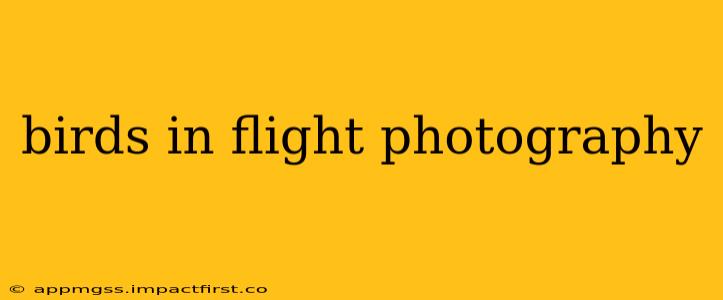Birds in flight—a breathtaking spectacle of nature's grace and power. Photographing these fleeting moments requires skill, patience, and the right equipment. This comprehensive guide will equip you with the knowledge and techniques to capture stunning images of birds soaring through the sky. We'll delve into everything from choosing the right gear to mastering the art of composition and post-processing.
What equipment do I need for bird photography?
This is a crucial starting point. While you can technically shoot birds with any camera, dedicated bird photography demands specific equipment for optimal results. A telephoto lens is absolutely essential, with a reach of at least 300mm, ideally 400mm or more. Longer lenses allow you to capture detailed images from a distance, minimizing disturbance to the birds. Consider a lens with image stabilization to compensate for camera shake, especially when using longer focal lengths. A fast shutter speed is critical to freeze the bird's motion, minimizing blur. This necessitates a camera capable of shooting at high shutter speeds. A fast autofocus system is also important to track the bird accurately, enabling sharp focus even during flight. Finally, a sturdy tripod will help to stabilize your camera, especially with heavier telephoto lenses.
What are the best camera settings for bird photography?
Mastering your camera settings is pivotal. Prioritize a fast shutter speed – generally 1/1000th of a second or faster – to freeze the bird's motion. A high ISO setting might be needed in low-light conditions, but be mindful of potential noise. Choose a wide aperture (low f-number, like f/2.8 or f/4) to allow ample light and create a shallow depth of field, blurring the background and emphasizing the bird. Use continuous autofocus (AI Servo or similar) to continuously track the bird as it moves. Experiment with different shooting modes; aperture priority (Av or A) allows you to control depth of field while the camera selects the appropriate shutter speed, while shutter priority (Tv or S) gives you control over the shutter speed.
How do I choose the right location and time of day?
Location scouting is paramount. Identify areas known for bird activity, such as nature reserves, wetlands, or coastal regions. Consider the time of day; the "golden hour" (sunrise and sunset) offers soft, warm light that's ideal for bird photography, minimizing harsh shadows. Cloudy days can also provide diffuse lighting that's suitable for shooting. Avoid midday sun, as it can create harsh contrasts and overexposed areas.
What are some tips for composing bird in flight photos?
Composition is key to creating compelling images. Consider the rule of thirds, placing the bird off-center to create a more visually appealing image. Use leading lines (branches, fences, etc.) to draw the viewer's eye to the bird. Pay attention to the background – a cluttered background can distract from the subject; a simpler, uncluttered backdrop will enhance the bird. Try to capture the bird in action – a bird taking off, landing, or in a dynamic pose adds visual interest. Experiment with different angles and perspectives; shooting from below can create dramatic images.
How can I improve my focus and tracking of birds in flight?
Accurate focus and tracking are crucial for sharp images. Practice using your camera's continuous autofocus mode. Pre-focus on an anticipated flight path, and anticipate the bird's movement. Use a monopod or tripod for added stability, particularly with longer lenses. Consider using back-button focusing, which allows you to control autofocus independently of the shutter release button.
How do I edit my bird in flight photos?
Post-processing can enhance your images. Adjust brightness, contrast, and sharpness. Remove any distracting elements from the background. Cropping can improve composition. Careful use of sharpening tools can enhance details. Be subtle with edits; the goal is to enhance, not to drastically alter, the image.
What are some common mistakes to avoid when photographing birds in flight?
Avoid shooting at too slow a shutter speed, leading to motion blur. Be wary of over-sharpening, which can introduce artifacts. Avoid overly processed images that look unnatural. Remember to respect the birds' natural habitat and avoid disturbing them.
By following these tips and dedicating time to practice, you'll be well on your way to capturing breathtaking bird-in-flight photographs. Remember, patience is a virtue in wildlife photography; persistence and observation will yield the best results.
